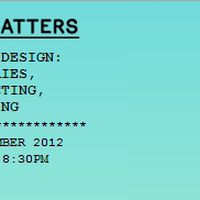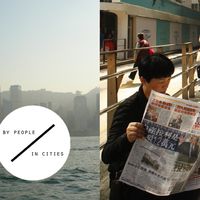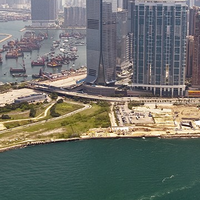By People / In Cities : Hong Kong | interview with Shirley Surya, Assistant Curator at M+ Museum

Former culture360.org Asia Editor, Sali Sasaki interviews Shirley Surya, Assistant Curator (Design & Architecture) at the M+ Museum in Hong Kong. The two met through the Royal College of Art in London (UK), and have since shared long conversations about the 'culture of design' and the shaping of culture by design in the 21st century.
In this interview Shirley shares her thoughts about the challenges linked to the 'transdisciplinary' nature of M+ in the way it encompasses visual art, design, architecture, and the moving image. She also talks about Hong Kong, a city shaped by its many layers and historical complexities, and which works as a nexus where ideas have been intersecting at a local, regional, and global level.
Q: How did you get to do what you do at M+?
Sometimes I wish I could plan my path. But considering how rare a design curatorial job in a museum is, particularly in this part of the world, it was sheer providence. I only knew of M+ when I saw the job posting, and was thrilled that design is part of its curatorial remit. Someone else could have gotten the job but perhaps my background in design publishing, History of Design with a focus on Asia, and archival project on an architectural practice in Beijing helped. Or maybe it was, on hindsight, my comment on being open to uncertainty during the interview.
Q: Where does M+ sit in the entire West Kowloon Cultural District project?
Conceptually, there is the official answer on our website and a 23-page paper by the Museums Advisory Group (MAG), a rather well-considered one I thought, on what the institution coined as “Museum Plus” (a museum and more, thus M+) is envisioned to be as part of the WKCD project – everything from its curatorial and collecting agenda, to its staffing plans and architectural parameters. Like the other performing arts facilities, the museum is meant to develop Hong Kong as ‘an international cultural metropolis’. Fortunately, things have gone beyond the official rhetoric as there’s already a curatorial team on board developing content through symposiums, talks and roving exhibitions while assembling the museum’s permanent collection in the run-up to the building’s opening in late 2017. Physically, and according to Foster + Partners’ masterplan, the future 62,000 sqm building sits at the end of the District’s main avenue, interfacing with the Park and overlooking Victoria Harbour.
Q: What would you think is the unique curatorial approach of M+?
According to the MAG report, M+ was planned to fill some gaps in the museum scene in Hong Kong.
Firstly, the report brought up the need for a museum that is more international in scope to facilitate a more dynamic exchange between cultural practices in Hong Kong and its global counterparts. The curatorial premise for M+ is thus one that comes ‘from a Hong Kong perspective with a global vision’. And as stated in our acquisition policy, this implies looking at global visual-cultural production through the lens of Hong Kong’s socio-political-cultural standpoint. For example, we acquired a three-channel video installation featuring triplet sisters called Factum Tang by South African artist Candice Breitz for its exploration on identity-formation – biological, racial or cultural – which we find relevant to the often discussed politics of Hong Kong’s identity as an unstable, sometimes reactionary, product to internal and external forces. Such a stance is certainly not unique, as museums elsewhere tend to develop its collection and programming to reflect its time and place. But with regards to the local-global dialogue, we are definitely aiming to be more deliberate in letting our collection and exhibitions reflect the historical implications of local, regional and global networks on visual-cultural production – beginning with Hong Kong, followed by China and Asia. Hopefully this could provide a more nuanced understanding of cultural hybridities across Asia and their relationships to the rest of the world.
Secondly, the report also brought up how there’s yet a museum with a primary focus on 20th to 21st century visual culture, encompassing art, design, architecture and the moving image. There are certainly museums such as the V&A and MoMA who have demonstrated superb ways of collecting and exhibiting visual art, design, and the moving image. Yet, the walls between these disciplines, or departments, could sometimes be impenetrable. So what we aspire to do could be considered as exciting but also a challenging one. How to investigate various aspects of visual culture, both autonomously and collectively, while retaining the particularities of each discipline – in terms of its histories, production processes and audiences – in a way that reflects the nature of creative practices in Hong Kong and the region, where a designer could have multiple hats as artist, photographer or filmmaker? How could M+ contribute to, and raise, the level of discourse and development of each of the disciplines of art, design and moving image, but also the productive and vital exchange between the disciplines? We can only answer this through learning by doing.
Q: As part of the curatorial team how would you describe your relationship with Hong Kong? Has this job changed your perception of the place? If so, in what way?
This is a tough question as there are so many aspects of Hong Kong to comment on. Being here as part of a team working to uncover and construct narratives of art and design in Hong Kong somehow makes me even more conscious of how one’s perception has to go through constant checks and revision. Like half of the curatorial team, my perception of Hong Kong is not based on a lived-in experience, but a comparative one, between what is happening here and where we lived and worked before – China, Europe, UK, USA, and South East Asia. Some may view such lack of “local” knowledge as a disadvantage. But a blank slate could also mean looking at things with fresh eyes, having less preconceived notions based on personal experiences or affiliations – something which designer Stanley Wong once pointed out to us “outsiders”. It also compels us to carry out due-diligence research through key texts, documentation, or interviews with key players and researchers. This process has been quite tedious, yet rewarding, as one’s perception of Hong Kong becomes more multivalent, shaped by the layered and complex narratives of its individuals, institutions, commerce and politics, in relationship to the region and other parts of the world. This also becomes more evident in light of a longer historical view.
So I don’t have a direct answer to your question. All I can say is, what I know to have happened, and are happening, here fascinate me enough to look closer and perceive the changes in a continuum. There are certainly recurring patterns that reinforce certain characteristics. For me, it is the city’s highly networked nature of cultural production, whether geographically – between the local, regional and global – or the various cultural disciplines of art, design and performing arts. It further proves how much of a nexus the city is – a condition not unique to Hong Kong but the intersecting of extremely varying cultures have created a distinct and accelerated potential, but also a reactive one. Some examples include Shanghai-based architects teaming up with British architects to form the Hong Kong Institute of Architects in the ‘50s based on the Society of Chinese Architects established in the ‘30s as well as the RIBA; former head of London’s Architectural Association Gordon Brown setting up the first architecture school with a curriculum based on close studies of local shanty towns in the ‘50s; US-trained architect Danny Yung's establishment of the city’s first avant-garde theatre group Zuni Icosahedron in the early ‘80s; graphic designer Alan Chan’s collaborations with Japanese clients and designers like Seibu and Ikko Tanaka in the late ‘80s; South East Asian tycoons of the Chinese diaspora having Hong Kong as its connecting hub to co-invest and share resources on each others’ real estate developments such that an architect like Paul Rudolph was behind key buildings in Hong Kong, Singapore, and Jakarta. The list could go on to show how Hong Kong has been such an intersection of ideas. Yet its transitory, liberal and hyperglobal condition has also led to reactive forms of nostalgia, self-protectionism, and ultralocalism.
Q: How are the external (global) influences impacting local culture?
I think this question is very much addressed earlier – how Hong Kong has derived its strengths, as well as trappings, as a result of this confluence of the “global” and the “local”. Yet I personally don’t think the line between the two should be drawn so clearly, especially in the realm of cultural production. Hong Kong’s historical position as an entrepôt also meant that what is “local” could also be a “foreign” concept first brought up through global exchange but embedded in local practices. By this I don’t mean a complete collapse of differences, but that I’m not sure if the binaries of the “local” and the “global” are that useful as opposed to seeing where they cross, or slip – something Prof. of Urban Design & Planning Rahul Mehrotra brought up at a panel discussion during the Architecture Biennale in Venice last year, on the age-old question of how global currents affect local practices. He pointed how the differences between the “local” and “global” are now much more nuanced and one needs to discern, and reveal, them in even more particular terms, not denying the messy terrain and how it is in the end a two-way flow. Artistic and design production in Hong Kong has surely been dramatically changed by external forces as it inevitably draws from frameworks and influences worldwide, from objects and ideas on the move at an even more accelerated way today. But Hong Kong is certainly not just at the receiving end. What happened in the 1980s, for example, was a major case in point when graphic designers and architects from Hong Kong were the first to enter China to renew its design curriculum, design its first hotels and new towns.
Q: What are some of M+ upcoming projects for the rest of 2013?
We just ended an outdoor exhibition of giant inflatables near the future site of the museum called "Mobile M+:Inflation!", and presented a solo show of Hong Kong artist Lee Kit at the Venice Biennale. So for the next few months, preparing for the announcement, and possible exhibition, of the winning design for the M+ building, and ongoing research to build up the permanent collection, will keep the team busy. We're also planning for an online-exhibition at the end of the year related to a disappearing, and very much under-researched, feature of Hong Kong's urban landscape.
[caption id="attachment_33805" align="alignnone" width="570"]
 Mobile M+:Inflation! - installation view 2013[/caption]
Mobile M+:Inflation! - installation view 2013[/caption]Shirley Surya (Singapore) is Assistant Curator (Design & Architecture) at M+, Hong Kong’s new museum for visual culture, as part of the West Kowloon Cultural District. Prior to M+, she was Curatorial Researcher for the retrospective exhibition “Yung Ho Chang + FCJZ: Material-ism” held at Beijing’s UCCA. Her writings on architecture and graphic design have been published by Design and Culture, The Design Society Journal, iSh, a+u, viction:ary and Page One Publishing. She received her B.A. in Media Studies at the University of California, Berkeley and M.A. in History of Design (Asian specialism) at the Royal College of Art.
Photo credits: Sam Kang Li for TDS Journal (top) and Nicholas Tse (installation view)
Similar content
from - to
03 Dec 2012 - 03 Dec 2012
31 May 2017
03 Dec 2012
posted on
15 Nov 2021
deadline
22 Jul 2016
deadline
30 Jun 2014






